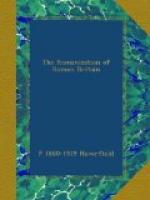[Footnote 1: E. Neil Baynes, Arch. Cambrensis, 1908, pp. 183-210.]
[Illustration: FIG. 12. NATIVE VILLAGE AT DIN LLIGWY, ANGLESEA.]
[Illustration: FIG. 13. LATE CELTIC METAL WORK, NOW IN THE BRITISH MUSEUM (1/3).
(Boss of shield, of perhaps first century B.C., found in the Thames at Wandsworth, a little before 1850.)]
CHAPTER V
ROMANIZATION IN ART
Art shows a rather different picture. Here we reach definite survivals of Celtic traditions. There flourished in Britain before the Claudian conquest a vigorous native art, chiefly working in metal and enamel, and characterized by its love for spiral devices and its fantastic use of animal forms. This art—La Tene or Late Celtic or whatever it be styled—was common to all the Celtic lands of Europe just before the Christian era, but its vestiges are particularly clear in Britain. When the Romans spread their dominion over the island, it almost wholly vanished. For that we are not to blame any evil influence of this particular Empire. All native arts, however beautiful, tend to disappear before the more even technique and the neater finish of town manufactures. The process is merely part of the honour which a coherent civilization enjoys in the eyes of country folk. Disraeli somewhere describes a Syrian lady preferring the French polish of a western boot to the jewels of an eastern slipper. With a similar preference the British Celt abandoned his national art and adopted the Roman provincial fashion.
He did not abandon it entirely. Little local manufactures of pottery or fibulae testify to its sporadic survival. Such are the brooches with Celtic affinities made (as it seems) near Brough (Verterae) in Westmorland, and the New Forest urns with their curious leaf ornament (Fig. 14),[1] and above all the Castor ware from the banks of the Nen, five miles west of Peterborough. We may briefly examine this last instance.[2] At Castor and Chesterton, on the north and south sides of the river, were two Romano-British settlements of comfortable houses, furnished in genuine Roman style. Round them were extensive pottery works. The ware, or at least the most characteristic of the wares, made in these works is generally known as Castor or Durobrivian ware. Castor was not, indeed, its only place of manufacture. It was produced freely in northern Gaul, and possibly elsewhere in Britain.[3] But Castor is the best known and best




